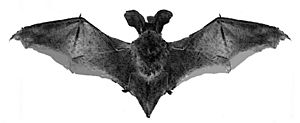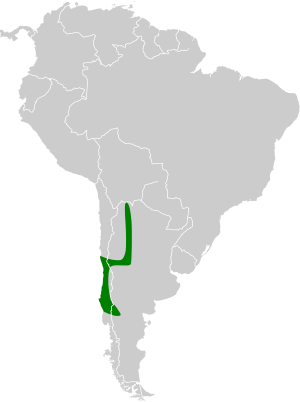Big-eared brown bat facts for kids
Quick facts for kids Big-eared brown bat |
|
|---|---|
 |
|
| Conservation status | |
| Scientific classification | |
| Genus: |
Histiotus
|
| Species: |
macrotus
|
 |
|
| Synonyms | |
|
|
The big-eared brown bat (Histiotus macrotus) is a fascinating type of vesper bat. These bats live in parts of South America, including Argentina, Paraguay, and Chile. They are known for their really big ears!
Contents
Discovering the Big-Eared Brown Bat
Who Discovered This Bat?
A German zoologist named Eduard Friedrich Poeppig first described the big-eared brown bat. He officially named it as a new species in 1835.
How Its Name Changed
When Poeppig first found it, he gave it the scientific name Nycticeius macrotus. Later, around 1875, scientists changed its name to what we use today: Histiotus macrotus. This is its current scientific name.
What Does the Big-Eared Brown Bat Look Like?
Its Most Amazing Feature: Big Ears!
As its name suggests, this bat has really large ears. These ears can be longer than 33 millimeters (about 1.3 inches). That's quite big for a bat!
Its Fur and Wings
The fur on the bat's back is a dark brown color. Its belly fur, however, is lighter and looks whitish. The parts of its body that are the darkest are its ears and its flight membranes. These membranes are like the skin that forms its wings.
Where Does the Big-Eared Brown Bat Live?
Its Home in South America
This bat species makes its home in South America. You can find it in countries like Argentina, Chile, and Paraguay.
Living at Different Heights
Big-eared brown bats can live in many different places. They have been found in areas from 240 meters (about 787 feet) all the way up to 3,600 meters (about 11,811 feet) above sea level. This shows they can adapt to various environments.
Is the Big-Eared Brown Bat Safe?
Conservation Status
Scientists keep track of how many animals there are in the wild. As of 2016, the big-eared brown bat is considered a least-concern species by the IUCN. This means that, for now, there are enough of these bats in the wild, and they are not in danger of disappearing.
See also
 In Spanish: Murciélago orejudo mayor para niños
In Spanish: Murciélago orejudo mayor para niños


